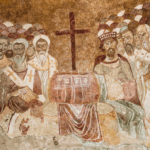The Word of God, our Lord Jesus Christ … did, through his transcendent love, become what we are, that he might bring us to be even what he is himself.
(Irenaeus of Lyons, Against Heresies, 5)
Over at our sister site, Professor D. Blair Smith recently cracked open a hoary old theological question of whether Jesus did his miracles by his divine nature or by the Holy Spirit? To put the question another way: when we look at the life of Jesus does it show us a perfect man, or does it show us someone who is unlike every other man?
It’s a tough question, and it is one that has been raised before on our own site in connection with certain confused Pentecostal ministries that argue that we can be just like Jesus (since we both do miracles by the Spirit).
It’s also a very worthwhile question. Many of our modern debates about evidence for the divinity of Jesus and others about the inner life of the Trinity turn on this matter. What are we looking at when we look at Jesus? What are we supposed to see? Does his human existence reveal or conceal his divinity?
Professor Smith offers a modest and careful response. He denies that we have to choose between Jesus divine identity and the Spirit and insists that we mustn’t allow questions of how he did his work to distract us from the basic fact that he was (and is) the same person as the eternal Son of God.
Jesus: Son-Man
But it might be possible to go a little further—to colour in between the lines a bit. The relationship between Jesus’ human life and his eternal personhood isn’t just a mystery or tension. We might also notice a kind of fit between human nature and Jesus’ eternal relationship to God the Father as son—a congruence that can help us understand both God and ourselves.
We can find basic pointers to this congruence pretty readily. For example:
- humans are made in the image of God, but God the Son is the image of God (e.g. Col 1:15).
- humans are made in God’s likeness but Jesus is the exact imprint of God (c.f. Heb 1:3)
- the first man Adam was in one sense the son of God (Luke 3:38); but the last and true man Jesus is literally the true, natural and eternal Son of God.
- humans were made to rule the world but the world was actually created by and for Jesus (Col 1:15; Eph 1:10)
That last point is spelt out by the writer of Hebrews. In Hebrews 2, he observes (from Psalm 8) that human rule is supposed to be universal: “everything in subjection to him … nothing outside his control” (Heb 2:8, emphasis added). But, as he immediately observes:
At present, we do not yet see everything in subjection to him. But we see him who for a little while was made lower than the angels, namely Jesus, crowned with glory and honour … (vv 8b-9)
His point is that humanity, up until the coming of Christ, has been living below its destiny. Even before the fall, humans didn’t possess the absolute authority Hebrews 2:8 demands—they were set up “a little lower than the heavenly beings” (Ps 8:5). Only in the one true man—in the Second Person of Trinity living as a descendant of Adam within creation—do we see the pattern completed. In him, and in him alone, humanity is what it was intended to be. Jesus is the one true man.
Up until the coming of Christ, humanity has been living below its destiny. Only in the one true man do we see the pattern completed.
A Son-Shaped Humanity
Pause and think about what this means for the questions we began with. Does Jesus’ authority over the wind and waves, over demons, over life and death and creation reveal his humanity or his divinity?
The answer is, “yes, both.” They reveal his humanity as well as his divine person because those two things mean the same—not because humanity is divine, but because “human”, in its truest and most authentic sense means God the Son—the second person of the Godhead—living as a creature and exercising all the power and authority of his Father in his Father’s name. He is the (true and only) Son of Man. Humanity is Son-shaped: it is designed especially for him.[1]
And yet it includes us.
“Human” finds its one true expression in Christ. But it doesn’t stop with him. As the writer of Hebrews 2 goes on to say, he brings “many sons to glory” (v10)—which, in this context seems to be a reference to (among other things) the way his death breaks the power of the devil who keeps us enslaved (v14). But this fits with the pattern we see throughout the New Testament. As Jesus lives as a human …
- honouring the Father with his obedience,
- overcoming temptation,
- speaking God’s words,
- exercising all authority over creation,
- atoning for sin,
- defeating Satan,
- ascending “far above all rule and authority and power and dominion, and above every name that is named (Eph 1:21)
… then he not only fulfils God’s plans for him, that he should enter creation, redeem it, and receive it as his inheritance (c.f. Heb 1:2-4).
… he also makes us incomplete and fallen humanoids truly human as well. In him—and only in him—we too begin to do those things listed above:
Just as we have borne the image of [Adam,] the man of dust, we shall also bear the image of the man of heaven. (1Cor 15:49)
And:
[God predestined us] to be conformed to the image of his Son, in order that he might be the firstborn among many brothers. (Rom 8:29)
Help for Christology
Now, of course, this certainly doesn’t answer all our questions. It doesn’t tell us how Jesus the man can be the same person as God the Son. It doesn’t solve the initial problem of the Spirit’s role.
But it does point a way forward. It helps us with our Christology by reminding us that Jesus isn’t just “God” and “man”: he is a particular person of the Godhead. Those things he is in his humanity fit with his eternal identity as Son.[2]
It also helps us to be Christocentric in our thinking about salvation history. The real story of the incarnation is not, in its deepest sense, Jesus coming to fix up our story. That great act of salvation and condescension was preceded by an eternal plan focussed on the Son himself. The plan to save us was subordinate to the Father’s plan to make Jesus king.
The story is not, in its deepest sense, Jesus coming to fix up our story. The plan to save us was subordinate to the Father’s plan to make Jesus king.
Jesus doesn’t fit into our story or our species. It’s much better than that. We are part of his story. His story is the real story. His incarnation is what humanity is really all about.
Help for Humans
This is the best news ever. And it is especially good news for us modern people who spend so much time trying to understand ourselves and makes something of ourselves.
We live in a time of desperate searching for our true natures. We keep looking for some key that will unlock our lives and help us to become the people we are supposed to be. Some of us hope to find it in our gender or sexuality or romantic relationships. Some of us try to find ourselves in careers and creativity. Many of us assess our lives by the warped standards of social media technology. We go to personality tests; we trawl through our family histories; we explore our ethnicity; we dig for hidden memories; we look to the signs of the zodiac.
Round and round we go, chasing our own tails.
But none of these things can tell us what we are really about—what our lives really mean. Only Jesus can do that. Only he can show us what we are supposed to become and actually help get us there. Only when we look to him do we discover ourselves both as individuals and human beings.
Becoming Ourselves in Him
I began this post with a classic quote from Irenaeus that has sometimes been used to justify wrongheaded speculations about how believers become divine. But viewed in a trinitarian framework, the bishop’s statement takes us to the heart of the incarnation. Because God the Son has indeed become what we are. He is humanity perfected. He is the origin and goal of our species. And he is also the one who makes us what he is; who offers himself to us as our brother; the one who leads us to the Father declaring “Behold, I and the children God has given me,” (Heb 2:13, NIV). In Christ, the Son incarnate, theology and anthropology come together. He is the good end of our story. He is the true answer to our muddled desires; the right answer to all our questions; the end of all our longings.
Glory to God.
[1] So 14th century Bryzantine, Nicholas Cabasilas:
It was not the old Adam who was the model for the new, but the new Adam for the old. For those who have known him first, the old Adam is the archetype because of our fallen nature. But for him who sees all things before they exist, the first Adam is the imitation of the second. (Nicholas Cabasilas, The Life in Christ, trans. C. J. De Catanzaro; Crestwood: St Vladimir’s Seminary Press, 1974), 190–191;)
[2] As Thomas Aquinas puts it:
It was most fitting that the Person of the Son should become incarnate … the Word of God, who is [God’s] eternal concept, is the exemplar likeness of all creatures. And hence man is perfected in wisdom (which is his proper perfection, as he is rational) by participating the Word of God, as the disciple is instructed by receiving the word of his master. (Summa 3.3.8)















